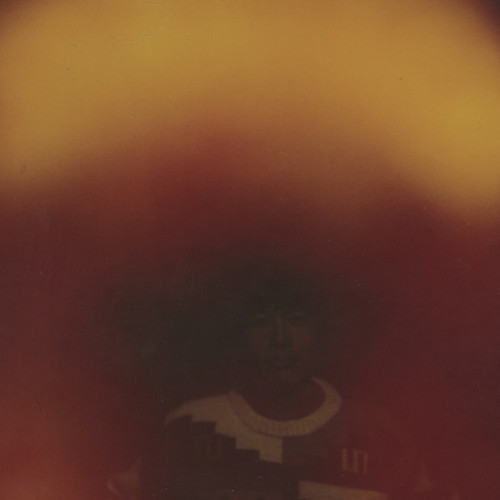It’s misleading to think of Dustin Wong as an explorer. Too often he’s been dubbed as such, ‘expanding’ or ‘exploring’ the sonic possibilities of his chosen instrument and a handful of pedals, yet he’s doing nothing as scientific, methodical or tangible as mere exploration. John Fahey famously explained how he “heard an orchestra in [his] head” while playing, but Wong’s guitar is not so much a baton as it is a paintbrush. He’s a painter and a poet, and it’s in the discrepancy between the image in his head and the sound in your ears that his indelible sonic personality comes to life.
From the opening fuzzed out bassy guitar punches and jittering spring reverb stabs of album overture, ‘The Big She’, it’s clear that Wong’s gingerly treading new and unfamiliar ground. Tonally the piece marches on with unsettling dissonance, evading the root notes and piling uneasy chords and interlocking lines that, though similar in size and shape to Wong’s previous work, imply a wholly different atmosphere to any predecessors. A distant vocal and off-kilter metronomic drum machine further muddy the rising confusion before Wong unexpectedly slices the loop sending the beat from tick-tock wandering into motorik overdrive, ushering in a closing coda of percussive Faustian jamming.
The debased and alien ‘Big She’ may not come to define the record, but its adventurous approach to composition and Wong’s varied and increasingly adept ability to craft near-unrecognisable sounds from his arsenal of pedals does. Much of the first half of the album following ‘Big She’ adheres to the Wong’s time-tested cascades of bouncy guitar melodies and arpeggios. The two-part suite of ‘Emerald Atmosphere’ and ‘Imaginelectric’ may indeed be the archetypal Dustin Wong compositions. Jittering lines of impossibly staccato guitar notes (pushed beyond the realms of human ability through looping and overdubbing) slowly build into bedrock grooves for psychedelic noodling. Like a game of Jenga, Wong removes and replaces elements of each track, morphing them into teetering melodic towers that ultimately and inevitably topple, only to subsequently rebuild them in one of the infinite number of new permutations. ‘Imaginelectric’ sees themes from ‘Emerald Atmosphere’ exhumed, reborn, and reshaped by Wong into another chapter in the journey. It’s as episodic an experience as it is holistic, and while Dreams Say, View, Create, Shadow Leads was similarly structured, Mediation Of Ecstatic Energy wins out in close-up, filled with beguiling and beautiful moments, and constantly colourful loop-pedal sleight of hand.
Wong’s chameleonic guitar vocabulary is now at its most expansive and dynamic, reminiscent of a banjo one moment and a Casiotone the next. On ‘Speeding Feathers Staring’ we’re met with delay pedal spacescapes akin to Inventions For Electric Guitar-era Manuel Göttsching or the intergalactic Echo heyday of Achim Reichel, while ‘Japan’ deadens and reduces the guitar to the point where it replicates the mesmerising bamboo abuse of an indonesian gamelan. Dustin Wong’s ability to evoke both the outer space of the former and the inner space of the latter is remarkable. The man’s no longer simply experimenting with the infinite number of sonic possibilities at his disposal, he’s composing with them – albeit in a very stream-of-consciousness way.
As is almost evident from the album titles alone, the maturation and increased focus since Dreams Say, View, Create, Shadow Leads has been substantial. Album highpoint, ‘Japan’, is undoubtedly Wong’s single best composition yet, relying not on simply playing with aesthetics and half-complete tunes (which has still produced memorable results – just listen to ‘Toe Tore Oh’ from Dreams Say) but on a masterful marriage of imagery and melody. The track’s way more uplifting than it should be, and paints a perfect picture of the cityscapes, mountains and many contradictions of the titular island and Wong’s adopted home. ‘Tall Call Cold Sun’ closes the album, calling upon the ghostly whispered vocals of Takako Minekawa. It’s a fittingly meditative and contemplative climax, repeating the chiming echo chamber beauty the pair trailblazed together on ‘Windy Prism Room’ earlier this year on Toropical Circle.
The album’s artwork includes a short story, apparently written with the same spontaneity as Wong’s compositional process for music. It’s fittingly abstract and bizarre, and the song titles across the album are in fact made up of select words extracted chronologically from the story, suggesting a narrative that may or may not be present in the music. This is all an exercise with interconnectedness, indeterminacy and mind-mapping, a representation of Wong’s own passive subconscious; the colours of the Tokyo skyline, the beaches of Waikiki and the ephemerality of time are all blurred and moulded into one incomprehensible whole by Wong’s vision. Or, perhaps not. Maybe the threads of imagery and meaning are a mirage of mine, and this is little more than an aesthetic work. Whatever it means, Mediation Of Ecstatic Energy is undoubtedly Wong’s most fully realised, varied and intriguing set of compositions to date.


